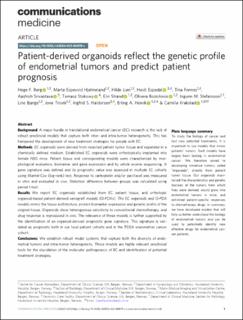| dc.contributor.author | Berg, Hege Fredriksen | |
| dc.contributor.author | Hjelmeland, Marta Espevold | |
| dc.contributor.author | Lien, Hilde Eide | |
| dc.contributor.author | Espedal, Heidi | |
| dc.contributor.author | Fonnes, Tina | |
| dc.contributor.author | Srivastava, Aashish | |
| dc.contributor.author | Stokowy, Tomasz | |
| dc.contributor.author | Strand, Elin | |
| dc.contributor.author | Bozickovic, Olivera | |
| dc.contributor.author | Stefansson, Ingunn Marie | |
| dc.contributor.author | Bjørge, Line | |
| dc.contributor.author | Trovik, Jone | |
| dc.contributor.author | Haldorsen, Ingfrid S. | |
| dc.contributor.author | Høivik, Erling Andre | |
| dc.contributor.author | Krakstad, Camilla | |
| dc.date.accessioned | 2022-02-09T10:19:14Z | |
| dc.date.available | 2022-02-09T10:19:14Z | |
| dc.date.created | 2022-01-26T00:05:30Z | |
| dc.date.issued | 2021 | |
| dc.identifier.issn | 2730-664X | |
| dc.identifier.uri | https://hdl.handle.net/11250/2977946 | |
| dc.description.abstract | Background: A major hurdle in translational endometrial cancer (EC) research is the lack of robust preclinical models that capture both inter- and intra-tumor heterogeneity. This has hampered the development of new treatment strategies for people with EC.
Methods: EC organoids were derived from resected patient tumor tissue and expanded in a chemically defined medium. Established EC organoids were orthotopically implanted into female NSG mice. Patient tissue and corresponding models were characterized by mor- phological evaluation, biomarker and gene expression and by whole exome sequencing. A gene signature was defined and its prognostic value was assessed in multiple EC cohorts using Mantel-Cox (log-rank) test. Response to carboplatin and/or paclitaxel was measured in vitro and evaluated in vivo. Statistical difference between groups was calculated using paired t-test.
Results: We report EC organoids established from EC patient tissue, and orthotopic organoid-based patient-derived xenograft models (O-PDXs). The EC organoids and O-PDX models mimic the tissue architecture, protein biomarker expression and genetic profile of the original tissue. Organoids show heterogenous sensitivity to conventional chemotherapy, and drug response is reproduced in vivo. The relevance of these models is further supported by the identification of an organoid-derived prognostic gene signature. This signature is vali- dated as prognostic both in our local patient cohorts and in the TCGA endometrial cancer cohort.
Conclusions: We establish robust model systems that capture both the diversity of endo- metrial tumors and intra-tumor heterogeneity. These models are highly relevant preclinical tools for the elucidation of the molecular pathogenesis of EC and identification of potential treatment strategies. | en_US |
| dc.language.iso | eng | en_US |
| dc.publisher | Nature Research | en_US |
| dc.rights | Navngivelse 4.0 Internasjonal | * |
| dc.rights.uri | http://creativecommons.org/licenses/by/4.0/deed.no | * |
| dc.title | Patient-derived organoids reflect the genetic profile of endometrial tumors and predict patient prognosis | en_US |
| dc.type | Journal article | en_US |
| dc.type | Peer reviewed | en_US |
| dc.description.version | publishedVersion | en_US |
| dc.rights.holder | Copyright the authors 2021 | en_US |
| dc.source.articlenumber | 20 | en_US |
| cristin.ispublished | true | |
| cristin.fulltext | original | |
| cristin.qualitycode | 1 | |
| dc.identifier.doi | 10.1038/s43856-021-00019-x | |
| dc.identifier.cristin | 1990004 | |
| dc.source.journal | Communications Medicine | en_US |
| dc.relation.project | Norges forskningsråd: 273280 | en_US |
| dc.relation.project | Kreftforeningen: 190202 | en_US |
| dc.relation.project | Helse Vest RHF: 12542 | en_US |
| dc.relation.project | Universitetet i Bergen: Annum | en_US |
| dc.identifier.citation | Communications Medicine. 2021, 1, 20. | en_US |
| dc.source.volume | 1 | en_US |

